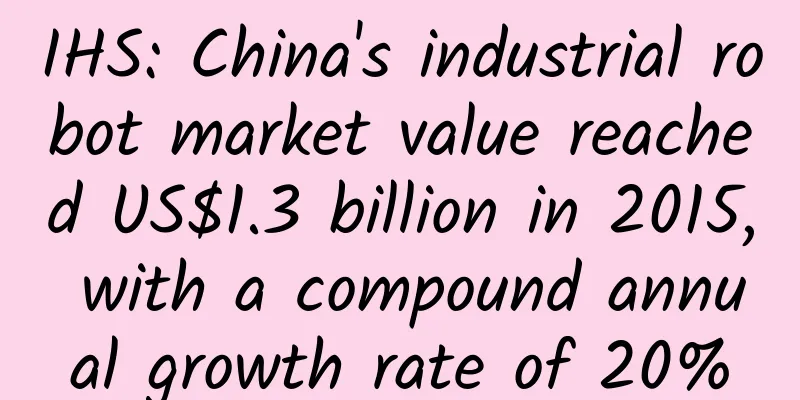IHS: China's industrial robot market value reached US$1.3 billion in 2015, with a compound annual growth rate of 20%

|
On April 20, 2016, according to statistics from IHS, a leading global market research and key insights provider, the value of China's industrial robot market reached US$1.3 billion in 2015, and will maintain a 20% compound annual growth rate (CAGR) to reach US$3.3 billion by 2020. In 2015, China's industrial robot sales revenue accounted for 13% of the world's total, and will reach 25% by 2020. Mr. Mark Watson, senior manager of manufacturing technology at IHS Technology, said that the recovery of the manufacturing industry will bring billions of dollars of development opportunities to the industrial robot market. Labor-intensive industries are increasingly inclined to automated production, especially in the Asia-Pacific region where labor costs are rising rapidly. Labor shortages have led to rising wages, which in turn has reduced the potential investment returns of many end users. After 2018, as the technology of end-user factories is optimized, the utilization rate of manufacturing capacity will increase, the application rate of industrial robots will increase, and the price of products will decrease. The application of industrial robots will be further expanded with the increasing labor costs, low commodity prices, and fierce competition with other regions with low manufacturing costs. Under the 13th Five-Year Plan, enterprises can increase their investment in robots due to direct credit and tax exemptions, which will be conducive to the growth of the industrial robot market. However, according to the latest research from IHS Industrial Robot Market Intelligence Service, with uncertain short-term economic prospects in China, many industries are experiencing overcapacity, especially in heavy industry, which will limit the growth of the industrial robot market. In this case, companies have little demand to improve productivity, so they are unlikely to install industrial robots on a large scale. Instead, they prefer to hire temporary workers because it is more flexible and less capital-intensive for local companies. But as China's economy continues to shift to a service-oriented economy, the problem of labor shortages will become increasingly apparent. Mr. Watson believes that enterprises need production flexibility and certain production efficiency, which lays the foundation for the application of industrial robots. After using robots, enterprises can easily adjust production levels and manufacturing processes, save labor costs, and reduce dependence on temporary workers. Foreign brands accounted for more than 80% of total industrial robot sales in China in 2015. These foreign brands dominate the Chinese robot market by establishing partnerships with leading domestic manufacturers to provide high-quality hardware, software and support services. Mr. Watson believes that the main competitors in China's industrial robot market have invested heavily in research and development to develop products with collaborative capabilities, deep learning capabilities, improve their artificial intelligence level and develop other emerging technologies to ensure that they occupy a favorable position in the industry competition. Therefore, local Chinese suppliers are facing a fierce battle for market share. |
<<: Besides VR, what else can leverage the Internet of Things in 2016?
>>: Industrial Big Data: Workshop IoT Data Management
Recommend
So cool! China's lunar suit debuts
On the morning of September 28, 2024, China's...
Huawei's temporary license has expired
Huawei cannot purchase parts and components from ...
What kind of advertising copy is considered creative?
1 The story originated from a brand service that ...
5 ways to promote WeChat mini programs!
According to the latest data, the main entrances ...
What does Jack Ma’s “ecosystem” really mean?
Alibaba's listing has become the hottest head...
The display effect of 4.7-inch iPhone 6 is like this
What will the iPhone 6 UI look like after it becom...
[Popular Science on Hot Fruits] Passion fruit has 100 kinds of aromas. How to open and enjoy it correctly?
Your browser does not support the video tag Where...
A brief discussion on APP operation and promotion: How to place advertisements accurately?
Preface: As of the end of March this year, accord...
10 questions for brands to start streaming on Douyin
These high-frequency questions almost list all th...
Have you been officially diagnosed as a "rat person" on the Internet? The reason may not be laziness, but low energy
Recently, a niche track has become popular on soc...
Research shows: Those who don’t wear masks or get vaccinated may be narcissistic?
Throughout the COVID-19 pandemic, experts have en...
A fitness blogger revealed that she had six uterine fibroids due to stress. Experts remind us: Uterine fibroids "prefer" these three types of people
Sports health blogger Zhou Liuye Zoey, who has 9....
50 tricks of cross-border marketing
No matter how the market environment changes, cro...
How can copy impress your users? Let’s add one more sentence: And then what?
When you go shopping, have you ever felt that som...









